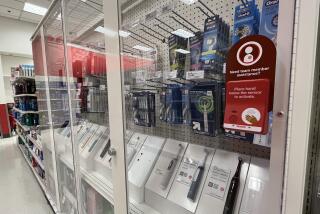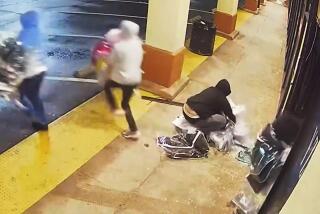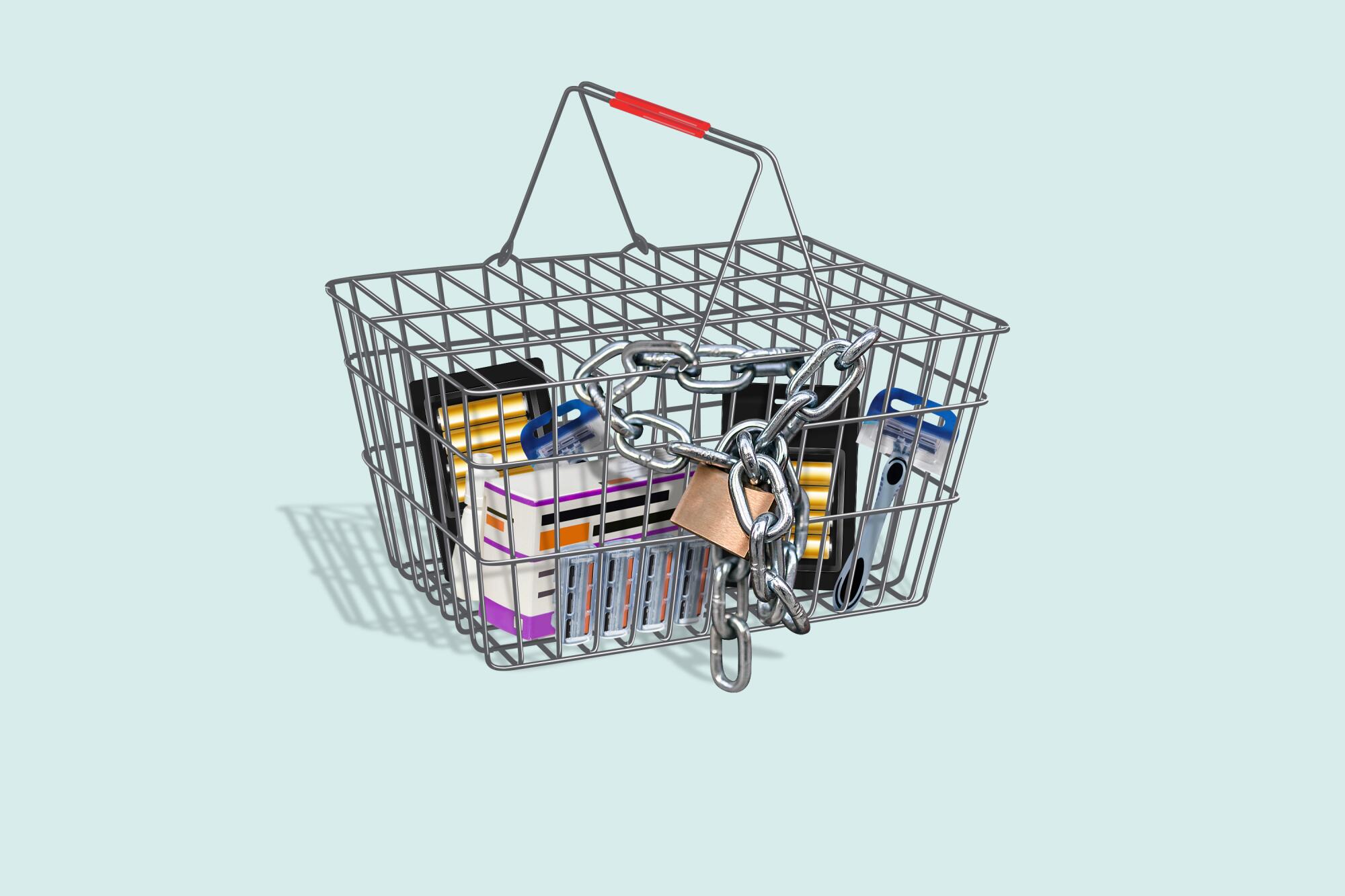
While shopping for decongestant at Walmart in Burbank, Michelle Krider ran into a frustrating sign of the times: The nasal spray was on a shelf, locked beyond plexiglass.
To get the decongestant, the Glendale resident had to press a red button on an electronic device mounted nearby that would summon a store worker to open the case.
But her patience ran out within two minutes, and she walked away before an employee could respond.
It’s a common problem as store managers add more and more security measures.
Where once only expensive booze and electronics were locked up, now basic household items such as allergy medicine, shaving razors, infant formula and batteries are ending up in plexiglass cases or behind security devices. More merchandise also has been moved to displays behind cashier counters.
Getting those products requires the help of increasingly scarce retail workers.
“Sometimes you have to call [for a store employee] and if they are busy, you have to wait,” said Angela Hakopyan, who was shopping for flu medicine at a Burbank Walgreens. “If I really need something, I wait. It’s annoying.”
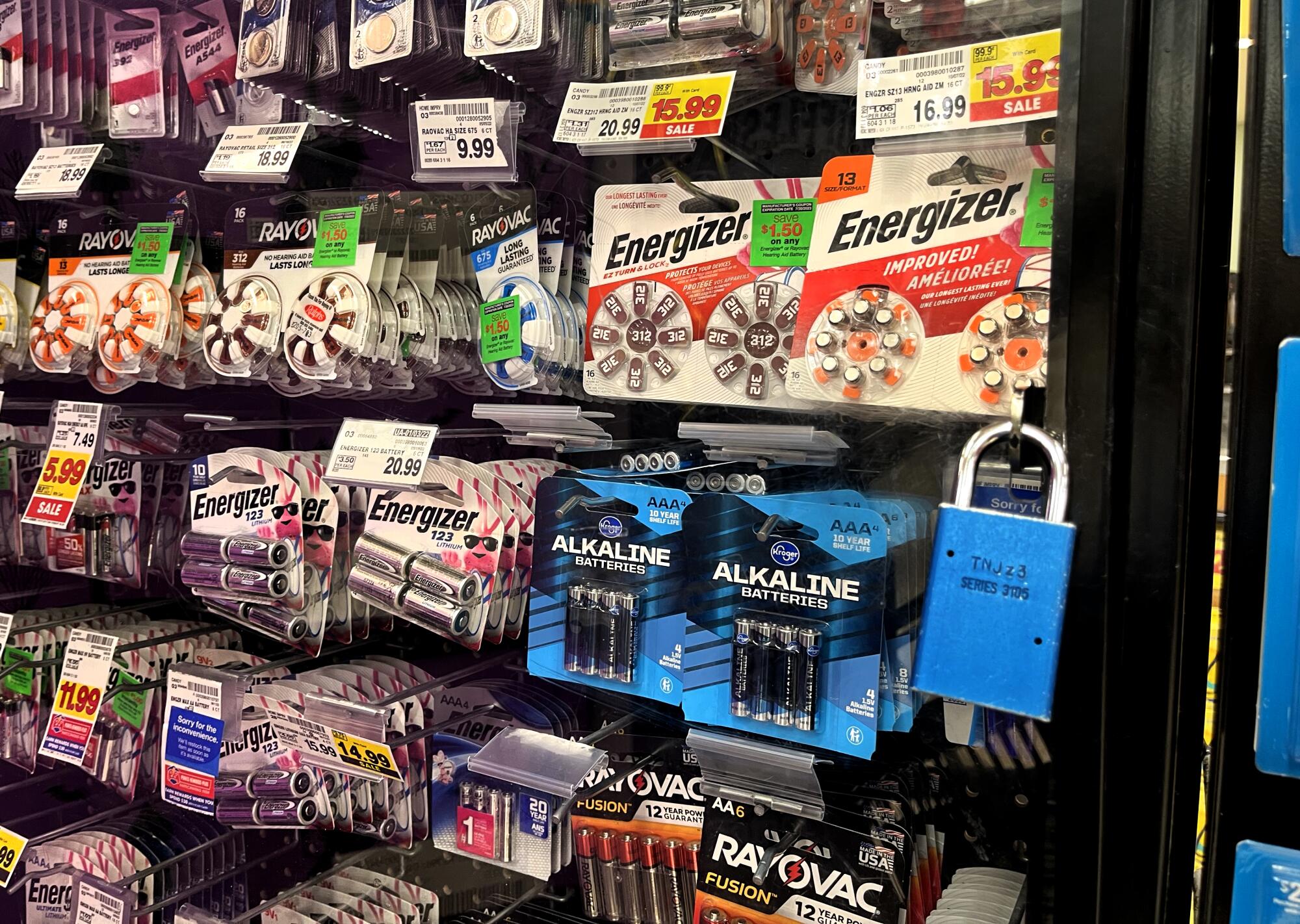
Industry experts and retail companies say the security measures are a response to rising retail crime.
“More people are stealing and stealing more,” said Read Hayes, a criminologist at the University of Florida and director of the Loss Prevention Research Council, an industry research group studying retail theft.
But a Times survey — albeit unscientific — of Los Angeles area drugstores suggests it’s not a straightforward equation, with stores in higher-income areas locking up fewer of the types of items that are most often stolen, even where the property crime rate is higher.
In so doing, critics say, chains discriminate against lower-income neighborhoods where most of the residents are people of color, creating an additional burden for shoppers there.
Inflation hasn’t been this high in decades. We compiled a snapshot of prices at ten grocery chains in the L.A. area. How does your local store stack up?
The dollar amount lost to retail theft is hard to measure but the National Retail Federation’s annual report estimated that at least $35 billion worth of products were lost in 2021 to shoplifting and theft by organized groups.
The trade association has noted that shoplifting and organized theft amount to less than 1% of sales, but its members have identified it as a “ballooning issue.” Retailers in the U.S. reported a 27% increase in retail crime incidents in 2021, according to a survey of retailers by the trade group.
The problem has been particularly acute in Los Angeles, which for the last four years has been identified by the National Retail Federation as the city with the worst organized retail crime problem, ahead of San Francisco/Oakland, New York and Houston. Organized retail crime goes beyond opportunistic shoplifting and includes black-market syndicates that resell stolen items in bulk at flea markets or to online sellers.
Those losses and the added cost of security measures are passed on to shoppers in the form of higher prices, although what you pay at the store is influenced by a host of factors, including rising labor costs, retail industry experts said.
“Retailers try to keep costs low for consumers but all of these investments have to be paid somehow,” said Jason Straczewski, vice president for government affairs for the National Retail Federation.
Added to the cost of product loss and new security measures is the decline in sales when shoppers like Krider don’t make a purchase because they are fed up by the wait to open a locked showcase or remove a security device, according to industry experts.
“Customers are frustrated, employees are frustrated and the retailers are frustrated,” Straczewski said.
Pharmacies and drugstores have been among the hardest-hit retail outlets because they often carry high-value, easy-to-conceal items that can be easily resold, according to experts and industry reports. Making matters worse for pharmacy customers is a national shortage of pharmacists due to increased burnout and the pressure added by the pandemic. That means longer wait times to pick up medications.
To get a sense of which stores are adopting the greatest number of security measures, The Times surveyed Southern California locations for the nation’s four largest pharmacies and drugstores: CVS Pharmacy, Rite Aid, Walgreens and Walmart. The four companies combined account for about 70% of the nation’s pharmacy and drug sales, according to the market research company IBIS World.
The Times visited 15 stores throughout Santa Monica, South Gate, Burbank, Glendale, Pasadena and Monrovia to compare the security measures in upper-income and middle- and working-class neighborhoods. We checked to see whether security measures were put on 15 individual items that were included in a list by the National Retail Federation of the top targets of organized retail crime. We added to the list a few that are often locked up in Southern California stores, such as Tide detergent pods and teeth whitening strips.
The survey was limited and by no means scientific, but the results give a sense of the kinds of items that retailers are locking up and how security measures vary by neighborhood.
- The items most likely to be locked or put out of reach behind a cashier’s counter are printer ink cartridges, phone charging cords and razor blades, followed by perfume, cologne and infant formula.
- Walgreens put security devices on more of the products we surveyed than the other three retail chains, an average of ten out of 15 items. Rite Aid had the least number of security measures, an average of seven out of 15 store items.
- Among the CVS and Rite Aid stores, the number of products with added security measures was higher at the stores in South Gate, where the median household income is $55,084, compared with stores in Santa Monica, where the median household income is $98,300. However, South Gate’s property crime rate — 3177.10 per 100,000 residents — is lower than Santa Monica’s property crime rate of 4138.55 per 100,000 residents, according to FBI crime statistics from 2020. The CVS store in South Gate had security measures added on 13 out of 15 items compared with nine items in its Santa Monica store. The Rite Aid store in South Gate had security measures added on eight out of 15 items compare with six out of 15 items in the Santa Monica store. The Walgreens in Santa Monica and South Gate had the same number of items with added security, 11.
- Although the number of items with added security measures varied very little among the Walmart stores we surveyed, we noted that all the outlets had partitioned off a portion of their pharmacy departments where high-priced health and beauty products are sold. If shoppers want to buy expensive cosmetics or shampoos they must enter the partitioned area and pay a cashier before leaving through a narrow exit back to the rest of the store. “No retailer is immune from theft, and Walmart isn’t any different,” Walmart spokesperson Charles Crowson said in a statement. “However, we don’t discuss specific details of illegal activity or security situations in our stores.”
The survey also uncovered seemingly bewildering security policies: Men’s razors were locked up at a Walgreens in South Gate but the women’s razors, which were priced about the same, were not. The Walgreens in South Gate also put dandruff shampoo in locked showcases but not regular shampoo.
Men’s underwear is locked up at several Walmart stores. To buy underwear at the Walmart store in Burbank, we had to wait 8½ minutes to get an associate to open the plexiglass case.
The number and types of security measures used in each store vary based on the crime problems in those stores, according to retail chain representatives and law enforcement experts.
“Different products experience different theft rates, depending on store location and other factors, affecting which products — and how — they are protected from theft at each store,” CVS spokesperson Mike DeAngelis said.
But community activists say the extra security measures adopted by retailers in some low-income neighborhoods are frustrating and often not justified by crime rates.
“Latino and African American neighborhoods have been racially profiled to have extra security measures in the stores that I believe aren’t even warranted,” said Najee Ali, a social and political activist in South Los Angeles.
The increase in retail crime has been blamed on several factors, including the financial blow of the pandemic and the resulting job losses, a recent surge in inflation and a growing perception that police and prosecutors won’t pursue petty crimes such as shoplifting, according to Hayes and other industry experts. Flash mobs that raid stores have also been on the rise.
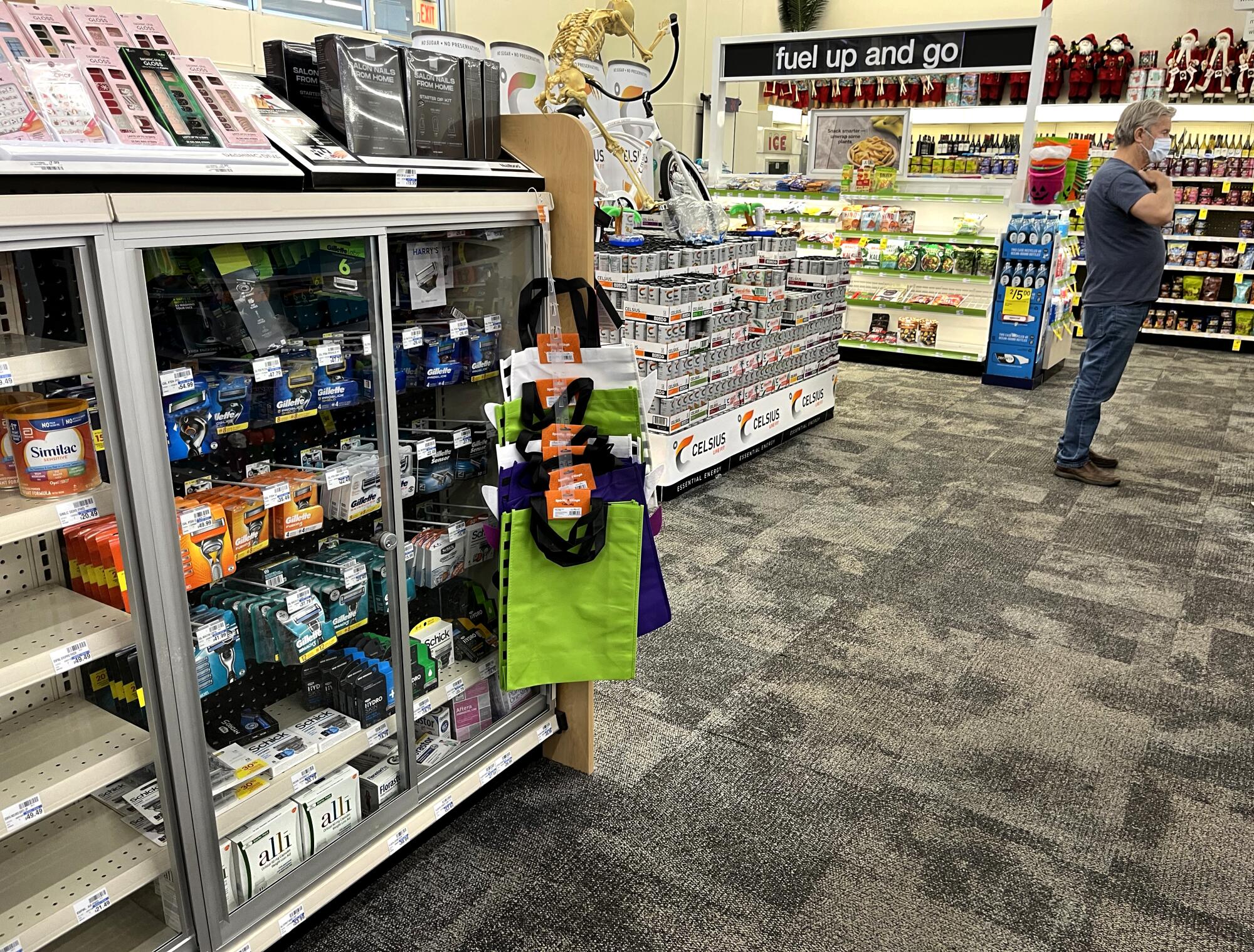
A tight labor market has aggravated the situation, making it more difficult for retail outlets to hire enough workers to keep an eye out for shoplifters or to answer customer requests for help getting a product. Keeping a worker employed in a store with a serious crime problem is not easy.
“If someone walks in and fills a garbage bag with stuff, employees don’t want to work there,” Hayes said. “They don’t feel safe.”
The problem has become so severe that Rite Aid executives recently groused that the “shrink” at Rite Aid stores was $5 million higher than in the previous three months and had forced the company to consider extreme measures. The company is in the midst of closing 145 stores in 17 states as part of a larger cost-cutting move.
“We’re looking at literally putting everything behind showcases to ensure the products [are] there for customers who want to buy it,” Andre Persaud, the company’s chief retail officer, said during a conference call with investors and analysts to discuss earnings. “And then lastly, we’ve even had to go to the extent of using off-duty police officers in some of our stores.”
Last year, Walgreens said it was closing an additional five stores in San Francisco, bringing the number of shuttered locations to 22 in the last several years, according to the San Francisco Chronicle. The company cited “organized retail crime” for some of the closings.
“It’s changing the shopping experience and causing stores to close their doors,” said Jason Daughrity, coordinator for the state’s Organized Retail Crime Task Force, created in 2019 and managed by the California Highway Patrol.
The retailers don’t always install extra security measures on the highest-priced items. At the Rite Aid store in Glendale, a Gillette pack of men’s razors, priced at $12.39, was locked behind plexiglass but a generic brand of razors displayed nearby and priced at $35.99 was not.
Hayes said retailers make decisions on what items to add security measures to based on how often the items are stolen and which stores have the highest rates of theft. “No one can afford to treat every item in every location the same,” he said.
Items including razor blades, medications, ink cartridges and cologne are often stolen because they have six criminal-pleasing characteristics that the industry has dubbed CRAVED: concealable, removable, available, valuable, enjoyable and disposable. By nabbing small, high-priced, easy-to-steal items, thieves minimize the risk of getting caught while maximizing the benefit of getting away with the crime.
Stolen items may end up being sold in bulk at flea markets or online platforms such as Facebook Marketplace, OfferUp, Craigslist or EBay, Daughrity said. Some criminals operate storefronts in residential homes to sell the stolen items and even place orders with shoplifters for products that have yet to be stolen, he said.
“Wherever there is theft, chances are there is a willing buyer,” Daughrity said.
Shoplifters working with organized retail crime rings will often enter a store with an empty garbage bag, which they will open under a shelf of valuable products, Hayes said. With a quick sweep of an arm, thieves can scoop dozens of items off a shelf and into the bag and sprint out of the store in seconds, he said.
As an apparent deterrent, Walgreens has begun displaying deodorant and body wash on shelves behind plastic barriers that are not locked but require shoppers to push them aside to get to the merchandise.
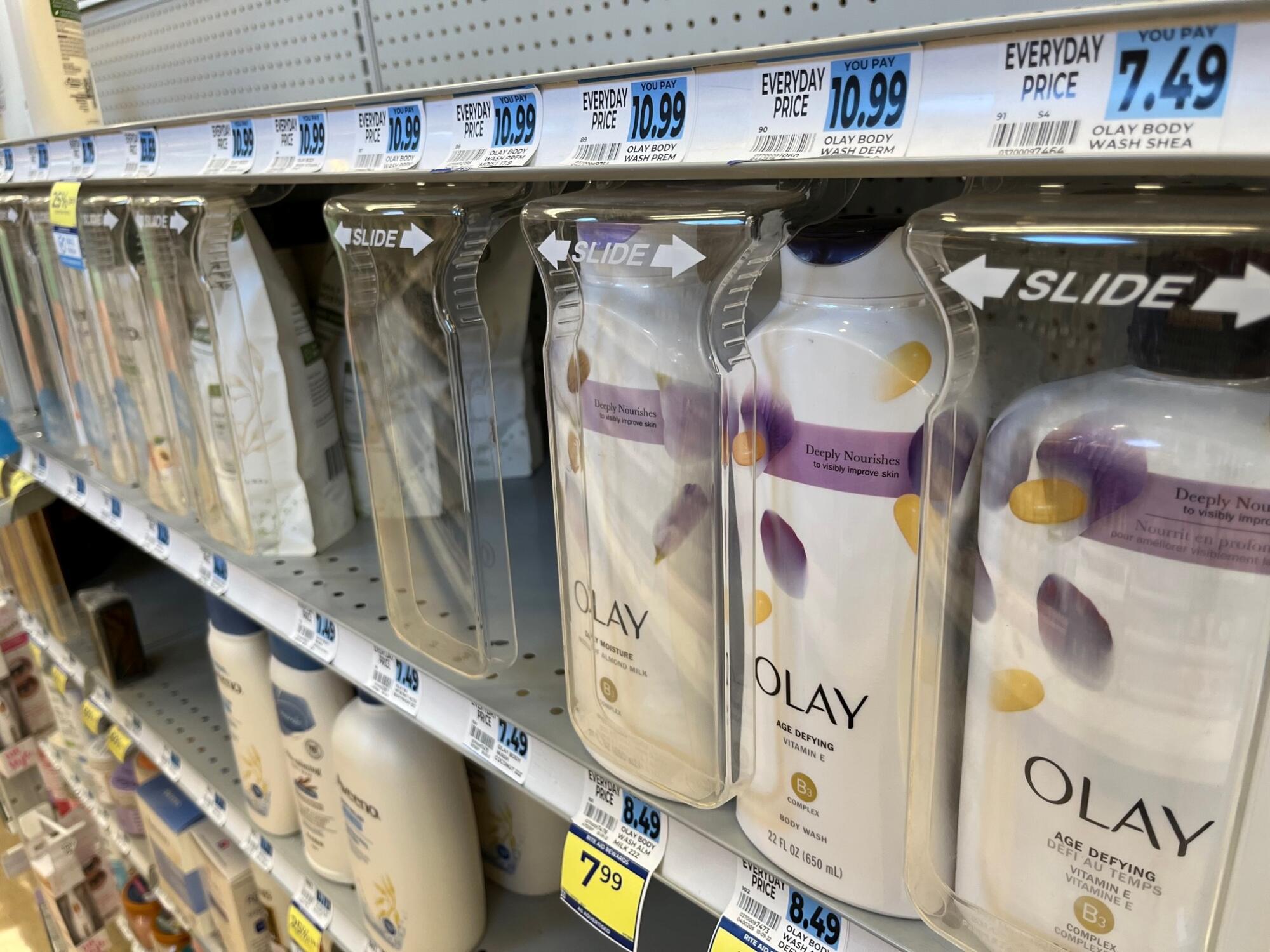
Walgreens wouldn’t discuss its specific theft-deterrent measures but said in a statement: “We take a multifaceted approach to deter theft and combat organized retail crime. For example, data-driven measures like installing anti-theft devices and security personnel helps to improve on-shelf availability of products for customers in stores.”
In a statement, Rite Aid said, “we are seeing a higher level of brazen shoplifting and organized retail crime, and we are taking an active role in helping the police in their pursuit of shoplifters.”
Nearly 45% of retailers who responded to a recent survey by the National Retail Federation said they were increasing their budgets to fight shoplifting. About 40% of retailers in the survey said they are adding or plan to add radio frequency identification tags, which can be attached to an item to locate it and identify if the item is stolen. Nearly 18% of those surveyed said they plan to or are adding more locked cases to display products.
But there is a cost to adding so many theft deterrents: Hayes and other retail crime experts say legitimate shoppers are likely to stay away from stores with too many security measures, especially on low-priced items.
As he stood outside the Walgreens in Santa Monica recently, Bill Robins frowned. “It’s a hassle,” he said. “So many items require you to ask for assistance before you can buy them.” He didn’t care that the stores were trying to protect their most commonly stolen items.
“It feels like it’s almost everything you buy here,” he said, “even razor blades.”

